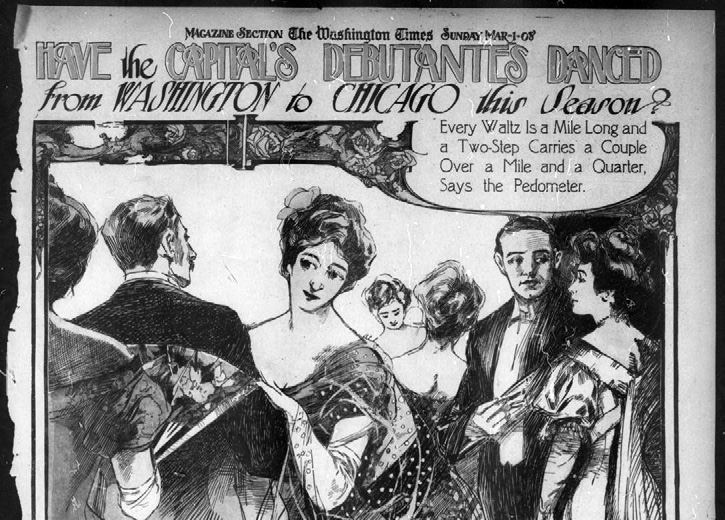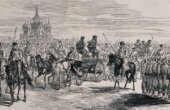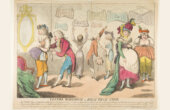Surveillance and the Secret History of 19th-Century Wearable Tech

On December 22, 1860, the Vincennes Gazette, an Indiana weekly paper, ran the following anecdote:
A lady who had read of the extensive manufacture of odometers, to tell how far a carriage had been run, said she wished some Connecticut genius would invent an instrument to tell how far husbands had been in the evening when they “just stepped down to the post office,” or “went out to attend a caucus.”
While the Indiana woman seemed not to know that such devices were already available, a Boston woman managed to perform exactly the kind of surveillance she described. According to a report in the October 7, 1879, Hartford Daily Courant, “A Boston wife softly attached a pedometer to her husband when, after supper, he started to ‘go down to the office and balance the books.’ On his return, fifteen miles of walking were recorded. He had been stepping around a billiard table all evening.”

Keeping track of individual activity — a kind of close certification or surveillance — was not limited to domestic relationships. Initially markers of wealth and power, pedometers adapted to serve individual accountability, especially in work settings. The Washington Evening Star ran a story in the fall of 1895 in which an admiral gave his junior watch officers what looked to them like a common pocket watch but was really a pedometer. The admiral tracked the junior officer’s night watch activities. To the admiral’s dismay, the morning reading showed just two and a half miles traversed overnight, suggesting that the ensigns had been sleeping or resting during most of their watch. The next night, those same ensigns ordered an apprentice to take the watchful pedometer and “shake it violently for four hours” while the night watchmen took their normal rest. While the hack worked insofar as the pedometer registered more miles traveled, it was a bit too effective: A distance of 89 miles traversed in 12 hours tipped the admiral off to the ruse.
Mrs. Jackson proudly shared her husband’s pedestrian cure with friends one night, only to learn that he shook the pedometer until it read five miles instead of taking his daily dose of activity.
Another story in the Railway and Engineering Review included a similar hack attempt by a Portland night watchman. Having previously been caught mechanically rigging the button-pushing work of his nightly rounds, the watchman was given a pedometer to ensure that he was manually completing his work. Although this use of quantum media — media that count, quantify, or enumerate — to more closely monitor the watchman’s activities seemed to work for several nights, he was eventually found sleeping in the engine room, having attached the pedometer to a piston rod.
These 19th-century hacks presage our own 21st-century example of Unfit Bits, a form of performance hack aimed at subverting corporate and insurance surveillance of human activity. As the pedometer became a vector for surveillance by those in power, people who were able quickly developed hacks designed to frustrate such efforts. Likewise, as the pedometer began to mediate lives rather than survey land, the impacts and risk shifted to the individual being measured who might face domestic discord or the loss of a job.
Consider Hannibal Jackson, a husband being tracked by his wife because she was concerned that he was not following his doctor’s orders. Mrs. Jackson proudly shared her husband’s pedestrian cure with friends one night, only to then hear his close friend report that each day, Hannibal had walked to the corner store, bought a cigar, and shook the pedometer until it read five miles instead of taking his daily dose of activity. When his wife expressed shock and disbelief, Hannibal confirmed his friend’s story and asserted that the joy of this ruse had in fact “cured” him of his previous ennui.
As Hannibal’s story suggests, by the late 19th century, quantum media tracking of human activity was not only tied to a particular body but also remediated these largely white, male elite bodies in ways linked to health and labor activities as opposed to the territory mapping seen elsewhere. By the 1890s, there is a marked uptick in newspaper reports of activity tracking as part of health and recreation. In the last quarter of the 19th century, large outlets like Scientific American as well as more local publications such as the Elk County Advocate (PA) and Lake County Star (MI) all ran stories on the health benefits of walking with a pedometer. Athletic clubs and physicians appear in the papers throughout the last decade of the 19th century, each using the pedometer to track the wearer’s activities for the purposes of self-reporting fitness or health.
Whose Steps Count Redux
While much of the popular discussion in the early 19th century focused on men’s uses of pedometers, in the second half of the century the devices became part of women’s fashion and close surveillance as well. The Atlanta Journal-Constitution announced in 1879 that “a pedometer is now an indispensable feature of every young ladies’ attire.” In a piece titled “A Slap at the Dancing Girl” that ran in the Los Angeles Times in the spring of 1890, a “frail consumptive Connecticut girl who wanted to attend a dance” but pleaded illness when asked to wash dishes was sent to the local dance by her father in a coach with two servants and a pedometer in her pocket. As the paper reported, “When she got home in the morning it indicated that she had danced enough to cover thirty-one miles.” Echoing yet inverting earlier textual accounts of women’s behavior, the paper suggested that the tracking revealed the untrustworthiness of young women.
As the pedometer became a vector for surveillance by those in power, people who were able quickly developed hacks designed to frustrate such efforts.
It was not just dances that were being tracked; the pedometer-monitored pedestrianism of the 19th century included women too. In 1878, Bertha Von Hillern walked 89 miles in 26 hours and reportedly “arouse(d) in women a sort of infatuation to go on the tramp wherever she travels.” According to one report, “Wherever Bertha goes,” women “begin to straighten themselves up and feel the muscles of the calves of their legs.” The “Slap” story and that of Von Hillern stand at two ends of the poles of the rhetoric around women’s pedometer usage. On the one hand, we have close surveillance in the example of the purportedly consumptive girl and a moral evaluation of her based on her activities, which include dancing but not washing dishes according to the story. One the other hand, Von Hillern’s story evokes the growing popularity of pedestrianism as sport along with the conspicuous consumption and performance enabled by wearing a pedometer during sport. Both are also framed by the gendered expectations around health and activity at the end of the 19th century.
In Von Hillern’s story we hear the anxiety and excitement around the increasing relative autonomy of white women in the late 19th and early 20th centuries as well as a suggestion that women’s bodies (the calves in particular) had been dormant and could be improved with physical exercise. In the story of the consumptive girl, domestic duties are reasserted as more valuable to her father than her social or physical activities. In both stories, the pedometer stands in as a technology able to reveal to anxious men the moral status of the woman being surveilled. Von Hillern can “tramp” as long as it is in the service of competitive sport as monitored by the pedometer. The consumptive girl, by contrast, is revealed to be someone more like the sexualized tramp, untrustworthy as a contributor to the household economy and dangerously prolific in physical interactions with men.
White women’s pedometer usage was also ambivalently documented at the turn of the century in the context of elite socialite cultures. The 1908 Washington Times magazine section ran a two-page spread on the pedometer fad at debutante balls that included a full-page graphic that figured the women as elegantly clad, with pedometers discreetly hidden beneath expensive gowns or tucked into bodices.

The text at the bottom of the ad reports that “after an evening at a ball the debutante can glance at her little pedometer and say to her escort in all truthfulness: ‘Well, I danced just twenty-one miles … this evening.’” The piece goes on to assert that the “pedometer is all the rage in the large cities,” having been imported from the London debutante scene. Suggesting that “no bud is truly elite unless she has a little ticker attached to her bodice,” and that “if one is close enough to the young debutante … one can hear the merry tick, tick of the little instrument,” the description is clearly meant to titillate. It at once positions a quantum media as a necessary accessory for cultural prominence and promises men an auditory experience that verifies physical proximity to the nation’s elite women. Even in the case of debutantes, the power of aggregated numerical data is lauded. The article goes on to note that “the facts shown by the figures” may well be “incredible,” but true, debutantes can be counted on to travel 900 miles as part of the Washington, DC, dance season. While the presence of the pedometer positions young women as cosmopolitan, “elite,” and desirable even in their labors, a cartoon in the Richmond Times-Dispatch illustrates that the step-counting craze threatened the social networking and partnering functions of the balls as women became more fixated on the numbers than their dancing partners.

Lamenting the spoiling of the dance season by the craze, the cartoon and the article to which it was attached suggested that instead of the appropriate work of nation and family building, the pedometer-wearing women are creating a “spectacle” in which the debutante is anxiously monitoring her steps while her dance partner sweats with exertion. While competitive walking helped to frame Von Hillern’s “tramping” in terms of national prestige, the pedometer-driven competition among the nation’s debutantes threatened to transform balls into sporting events that leveraged men’s physical exertion in dancing rather than served their matrimonial or sexual desires.
Animals and Children
The fascination with measuring bodies extended beyond the social realm of pedestrian competitions and dances to include yet another new context: using pedometers as instruments for scientific research involving animals and children. “In the Interest of Temperance,” a story that ran in newspapers in the summer of 1896, relates the work of a “Professor Hodge” who was studying the effects of alcohol on canine activity. Working with two pairs of cocker spaniels, Rum and Tipsey and Nig and Topsy, Hodge uses pedometers worn by the dogs to measure the activity of the animals over the course of the day. According to the article, “The prohibitionist pair are trotting about nearly all day, while the tipplers (who had been given a daily diet of alcohol) were especially active at night.” For Hodge, the pedometer served as a watchful device that could track his canine subjects even when he was away. This scientific use of pedometers was not isolated: Other pedometer studies include one in the American Journal of Sociology, on children’s playground activity, and one in Animal Husbandry, on bovine menstruation in the first part of the 20th century.
In such examples, the pedometer is assumed to provide accurate knowledge of the hard-to-track phenomena, whether that’s 24-hour canine activity, children’s play, or the mysteries of cow ovulation. In addition to specific studies, leveraging quantum media like pedometers to track the amount of activity that a body performs in a day of work or recreation became widespread. The Pacific Commercial Advertiser, once the largest daily newspaper in Hawaii, ran a large chart in 1900 enumerating the miles women walked in the course of their housework, and the Washington Evening Star ran a similar accounting of an office carrier’s travels in a day.
The early application of pedometers for domestic and social surveillance reveals a broader societal shift, as devices once emblematic of power and prestige became instruments of intimate monitoring and control. From professional oversight to social propriety, the pedometer served as a subtle but powerful mediator, quantifying life in ways that both reflected and challenged evolving norms of individual accountability and public transparency. As these early examples suggest, the tension between surveillance and self-improvement, between control and liberation, is a recurring theme in the history of wearable technology.
Jacqueline D. Wernimont is Distinguished Chair of Digital Humanities and Social Engagement and Associate Professor of Women’s, Gender, and Sexuality Studies at Dartmouth College. She is the author of “Numbered Lives,” from which this article is adapted.



